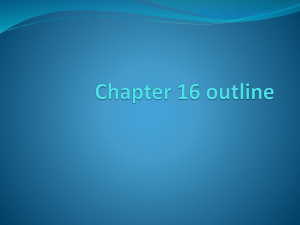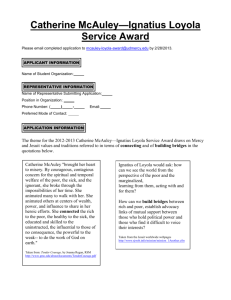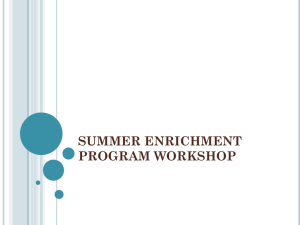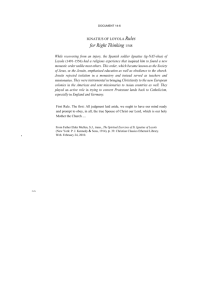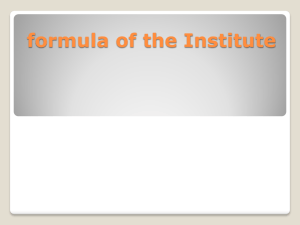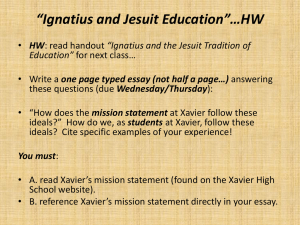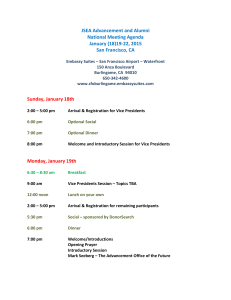Jesuits: Ignatius Loyola
advertisement
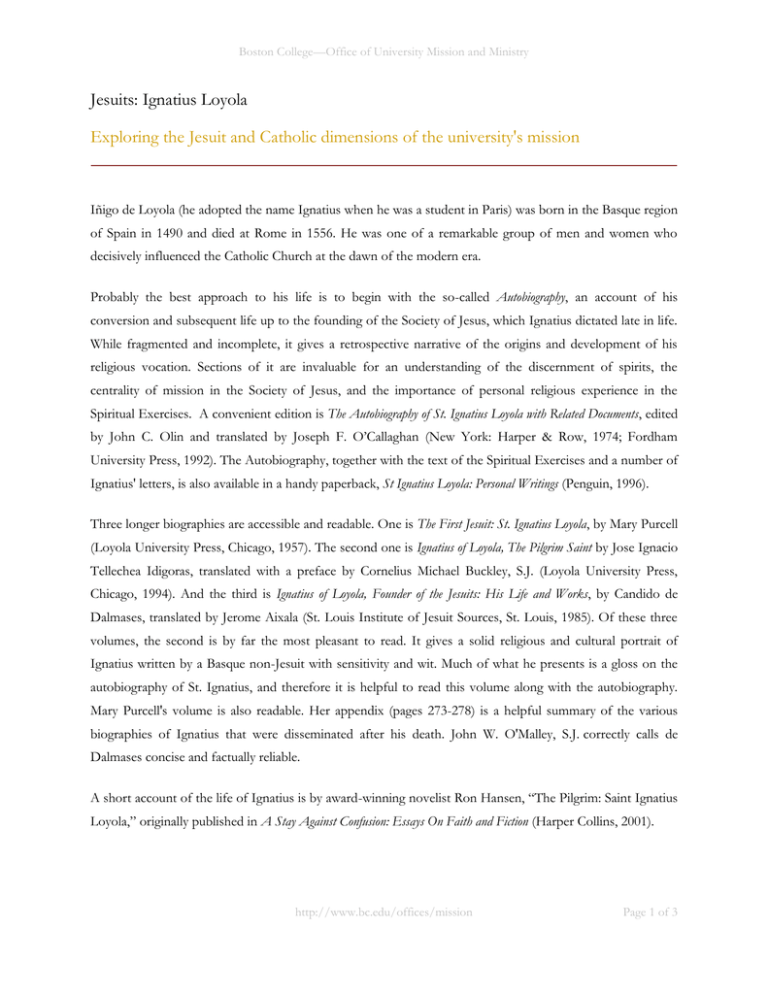
Boston College—Office of University Mission and Ministry Jesuits: Ignatius Loyola Exploring the Jesuit and Catholic dimensions of the university's mission Iñigo de Loyola (he adopted the name Ignatius when he was a student in Paris) was born in the Basque region of Spain in 1490 and died at Rome in 1556. He was one of a remarkable group of men and women who decisively influenced the Catholic Church at the dawn of the modern era. Probably the best approach to his life is to begin with the so-called Autobiography, an account of his conversion and subsequent life up to the founding of the Society of Jesus, which Ignatius dictated late in life. While fragmented and incomplete, it gives a retrospective narrative of the origins and development of his religious vocation. Sections of it are invaluable for an understanding of the discernment of spirits, the centrality of mission in the Society of Jesus, and the importance of personal religious experience in the Spiritual Exercises. A convenient edition is The Autobiography of St. Ignatius Loyola with Related Documents, edited by John C. Olin and translated by Joseph F. O’Callaghan (New York: Harper & Row, 1974; Fordham University Press, 1992). The Autobiography, together with the text of the Spiritual Exercises and a number of Ignatius' letters, is also available in a handy paperback, St Ignatius Loyola: Personal Writings (Penguin, 1996). Three longer biographies are accessible and readable. One is The First Jesuit: St. Ignatius Loyola, by Mary Purcell (Loyola University Press, Chicago, 1957). The second one is Ignatius of Loyola, The Pilgrim Saint by Jose Ignacio Tellechea Idigoras, translated with a preface by Cornelius Michael Buckley, S.J. (Loyola University Press, Chicago, 1994). And the third is Ignatius of Loyola, Founder of the Jesuits: His Life and Works, by Candido de Dalmases, translated by Jerome Aixala (St. Louis Institute of Jesuit Sources, St. Louis, 1985). Of these three volumes, the second is by far the most pleasant to read. It gives a solid religious and cultural portrait of Ignatius written by a Basque non-Jesuit with sensitivity and wit. Much of what he presents is a gloss on the autobiography of St. Ignatius, and therefore it is helpful to read this volume along with the autobiography. Mary Purcell's volume is also readable. Her appendix (pages 273-278) is a helpful summary of the various biographies of Ignatius that were disseminated after his death. John W. O'Malley, S.J. correctly calls de Dalmases concise and factually reliable. A short account of the life of Ignatius is by award-winning novelist Ron Hansen, ―The Pilgrim: Saint Ignatius Loyola,‖ originally published in A Stay Against Confusion: Essays On Faith and Fiction (Harper Collins, 2001). http://www.bc.edu/offices/mission Page 1 of 3 Boston College—Office of University Mission and Ministry The painter Peter Paul Rubens (1577-1640), a product of Jesuit education at Cologne, became a close friend of the Jesuit order. His "Pictorial Biography of Saint Ignatius Loyola" is available in a delightful volume entitled Constructing a Saint Through Images (St. Joseph's University Press, Philadelphia, 2008). While Loyola's Acts: The Rhetoric of the Self, by Marjorie O'Rourke Boyle (University of California Press, Berkeley, 1997) has a number of idiosyncratic features, it is an important critique of the autobiography. There are a couple of editions of the other works of Ignatius that are worth knowing about, especially for their introductions and notes: Commentaries on the Letters and Spiritual Diary of St. Ignatius Loyola by Simon Decloux (Centrum Ignatianum Spiritualitatis, Rome, 1982) and The Spiritual Journal of St. Ignatius Loyola, translated by William J. Young (Woodstock College Press, Woodstock, (Maryland), 1958). In addition to the Autobiography and the Spiritual Exercises (see the section of this web site on Ignatian spirituality), Ignatius wrote the original Constitutions of the Society of Jesus. The older standard edition in English is Constitutions of the Society of Jesus, translated with an introduction and commentary by George E. Ganss (St. Louis: Institute of Jesuit Sources, 1970). Another respected commentary available in English is An Introductory Commentary on the Constitutions, by Antonio LM. De Aldama, S.J., transl. Aloysius J. Owen, S.J. (Institute of Jesuit Sources, 1989). A revision of the Constitutions that includes all the subsequent legislation amending and interpreting the original text was published in 1996: The Constitutions of the Society of Jesus and Their Complementary Norms: A Complete Translation of the Official Latin Texts, ed. John W. Padberg, S.J. (Institute of Jesuit Sources, 1996). Dated but invaluable as a background for understanding Ignatius and Jesuit spirituality is the English translation of Joseph de Guibert's The Jesuits: Their Spiritual Doctrine and Practice – A Historical Study, translated by William J. Young, S.J. and edited by George E. Ganss, S.J. (The Institute of Jesuit Sources, St. Louis, 1964). While de Guibert has been criticized as writing what is sometimes called "court history," the introduction and Part 1 of his work present a tradition that is important to understand in evaluating the revolutionary work that John W. O'Malley has done in The First Jesuits (Harvard University Press, 1993). O'Malley built on the older tradition of hagiography and spirituality to present a picture not so much of Jesuit thought but of what Jesuits were doing. In a real sense, O'Malley's book is a historical presentation of what we mean by the "Ignatian way of proceeding." More venturesome souls may be interested in Ignatius of Loyola: The Psychology of a Saint, by W.W. Meissner, S.J., M.D., a psychoanalyst and writer about psychology and religion, who wrote this study while a member of the Boston College Theology faculty (New Haven: Yale University Press, 1992). http://www.bc.edu/offices/mission Page 2 of 3 Boston College—Office of University Mission and Ministry A rich and immensely rewarding volume is The Jesuits: Cultures, Science and the Arts 1540-1773, edited by John W. O'Malley, S.J et al. (Toronto: University of Toronto Press, 1999). This volume consists of papers given at an international conference held at Boston College in May 1997. The essays take a variety of approaches, ranging from mathematics and science, to art and music. However, there is a focus in the volume, namely, how from the very beginning the Jesuits both engaged culture and were engaged by their cultures so that this mutuality of influences created something that was unique in the personality of religious orders within the Catholic Church. Among the essays that would be extremely helpful for people in higher education are those by O'Malley on the historiography of the Society of Jesus today, Steven Harris on mapping Jesuit sciences, T. Frank Kennedy on Candide and a Boat, Andrew Ross on Alessandro Valignano, Francis Clooney on Roberto de Nobili's Dialogue on Eternal Life, and Gauvin Bailey's "The Truth-Showing Mirror". Through the years there has been a number of individual studies that trace the influences on St. Ignatius from the culture and the piety of his day. An older volume but still extremely valuable is Ignatius of Loyola, His Personality and Spiritual Heritage, 1556-1956, edited by Friedrich Wulf, S. J. (Institute of Jesuit Sources, St. Louis, 1977). This volume is a symposium of scholarly and document studies in which a number of outstanding German Jesuits collaborated, among them Hugo and Karl Rahner. Especially helpful for an educator is the article on "Elements of Crusade Spirituality" by Hans Wolter, S.J., "Toward the History of Ignatius' Teaching on the Discernment of Spirits," by Hugo Rahner, and "The Ignatian Process for Discovering the Will of God in an Existential Situation," by Karl Rahner. These essays are both important and helpful because they summarize scholarship in relevant areas up to 1956. http://www.bc.edu/offices/mission Page 3 of 3
